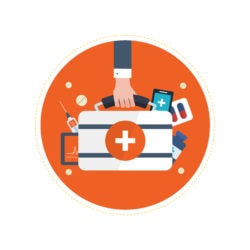It’s the beginning of a New Year and you are probably thinking about the goals that you want to accomplish within the next 12 months. Doctors and healthcare providers of all kinds set goals, but they may not always be the right ones. This article looks at one of the most important goals to focus: improving bedside manner. It’s an often over-looked skill, but it is critical to establishing rapport with patients and using effective communication.
In a fast-paced environment, healthcare providers have a hard time communicating with patients. This leads to miscommunications and patients who are confused or uncooperative. Yet, it’s important that we not forget how big of a role the patients actually play in the success of their own healthcare. That’s what brings us to this topic.
Bedside manner refers to the way a healthcare provider interacts with a patient. It includes the provider’s demeanor, communication style, and overall approach to patient care. It influences patients’ satisfaction with their care, their compliance with treatment recommendations, and their overall health outcomes.
Why Is Bedside Manner Important?
Because it can greatly affect the patient’s experience and treatment results, bedside manner is crucial. A doctor with a good bedside manner can put the patient at ease, which can improve communication and help the patient grasp their condition and course of treatment. As a result, the patient may experience improved health outcomes in the long run. Contrarily, a clinician with bad bedside manner might make their patient feel more stressed and anxious, which can have a detrimental effect on their health and level of satisfaction with their care.
Achieving the best clinical results also requires building trust with patients. It is very difficult for a patient to trust a healthcare provider if he/she doesn’t like their attitude or approach. Even if the information provided is essentially the same, trust is required for patient buy-in. Only then can patients successfully collaborate with treatment plans, rehabilitation, and following advice for a healthy outcome.
And statistics back this up. One study that compiled the results of more than a dozen randomized, controlled trials found that relationship-based care had a statistically significant impact on health outcomes for patients with obesity, diabetes, asthma, or osteoarthritis. It was also related to improvements in pain management, blood pressure, blood sugar, and cholesterol levels, among other things. In fact, the impact was bigger than the effects of low-dose aspirin or cholesterol-lowering statins for preventing heart attack, according to the researchers.
Additionally, when patients feel comfortable and respected, they are more likely to return for future care.
What Are the Characteristics of Good Bedside Manner?
Good bedside manner is characterized by communication, empathy, and compassion. A medical professional who has good bedside manner can relate to their patients and comprehend their thoughts, feelings, and experiences. Additionally, he or she strives to make patients feel at ease and understood while still being empathetic and kind.
“The MGMA-Healthgrades analysis shows 52% of patients mentioning the need for their doctor to have at least one of the following: compassion, comfort, patience, personality or bedside manner. Healthcare consumers view healthcare first and foremost as a personal interaction and not just a medical transaction.”
As reported by Forbes
Let’s make a list of what traits and skills define positive bedside manner.
- Being respectful and considerate of the patient’s feelings and concerns.
- Taking the time to listen carefully to the patient and answer their questions thoroughly.
- Using clear and simple language
- Being patient and empathetic, and showing genuine concern for the patient’s well-being.
- Being open to feedback and working together with the patient to make the best plan their care.
- Providing physical comfort, such as offering a blanket or pillows, as appropriate.
- Reserving judgment about patients. Health care providers may not agree with the decisions patients make or their lifestyle, but this should never influence how they treat an individual.
- Being professional and maintaining confidentiality.
- Having a sense of humor is often helpful, when appropriate.
- Recognizing when referring them to another expert is the best option for the patient.
Overall, good bedside manner involves treating the patient as a whole person and not just a set of symptoms or a medical problem to be solved.
Related article: Redefining Great Patient Care.
Points for Improving Bedside Manner and the Patient Experience
Active Listening
Make a conscious effort to be present and focused when interacting with patients. Put away distractions like your phone or computer, and give the patient your full attention. Active listening means not just hearing what the patient is saying, but also paying attention to their nonverbal cues and asking clarifying questions to make sure you understand their concerns and needs.
It may be helpful to take notes, like write down the patient’s concerns so that you can circle back and address them properly.
Clear Communication
Knowing how to explain diagnoses, treatments, side effects, and risk so the patient understands. This means speaking to the patient in a way that is easy to understand, using plain language rather than medical jargon.
Try to anticipate the patient’s needs and be proactive in addressing them. But also, be prepared to repeat things you have already said. It’s normal that patients aren’t able to absorb all the information given to them when emotions are running high, so slowing down and repeating the key bits can be reassuring.
Positive Approach
Healthcare providers essentially set the tone for patient relationships. That’s why it’s important to have a positive outlook. This can be put into practice by offering words of support or encouragement.
Accessibility
Patients really appreciate timely communication and having a doctor who is available to answer questions, respond quickly to patients, and check in regularly.
In the same way, healthcare providers need to be respectful of the patient’s time and schedule. Avoid keeping them waiting unnecessarily and be prompt in starting and ending appointments.
Related article: Patients’ #1 Complaint: When They Can’t Get in Contact with the Doctor.
PatientCalls Helps Providers be More Accessible to Patients
Your practice doesn’t need to hire more receptionists or full-time front desk staff, PatientCalls works on an as-needed basis to augment the staff you already have. We are trained to work in the healthcare industry and our operations are in full compliance with HIPAA regulations. With our 24/7 live answering service, your practice can deliver after-hour availability to all your patients, without losing any sleep.







